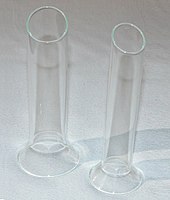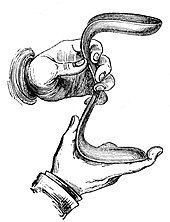Speculum (medicine): Difference between revisions
No edit summary |
No edit summary |
||
| Line 138: | Line 138: | ||
* [[Endoscope]] |
* [[Endoscope]] |
||
* [[Luce Irigaray]], writer of ''Speculum of the Other Woman'' (1974) |
* [[Luce Irigaray]], writer of ''Speculum of the Other Woman'' (1974) |
||
| ⚫ | |||
| ⚫ | |||
==Notes== |
==Notes== |
||
| Line 143: | Line 146: | ||
{{reflist}} |
{{reflist}} |
||
{{Surgical instruments}} |
{{Surgical instruments}} |
||
| ⚫ | |||
| ⚫ | |||
{{DEFAULTSORT:Speculum (Medical)}} |
{{DEFAULTSORT:Speculum (Medical)}} |
||
Revision as of 11:46, 26 February 2012

A speculum (Latin for "mirror") (plural specula or speculums) is a medical tool for investigating body cavities, with a form dependent on the body cavity for which it is designed. In old texts, the speculum may also be referred to as a diopter or dioptra.[1] Like an endoscope, a speculum allows entry into a body cavity; endoscopes, however, tend to have optics while a speculum is intended for direct vision.
History
Vaginal and anal specula were used by the ancient Greeks and Romans,[2] and speculum artifacts have been found in Pompeii.[3] A vaginal speculum, developed by J. Marion Sims, consists of a hollow cylinder with a rounded end that is divided into two hinged parts, somewhat like the beak of a duck. The speculum is inserted into the vagina to dilate it for examination of the vagina and cervix.
Construction
All specula were formerly made of metal, and sterilized after use. However, many, especially those used in emergency departments and doctor's offices, are now made of plastic, and are sterile, disposable, single-use items. Those used in surgical suites are still commonly made of metal.
Types of specula

Specula come in a variety of shapes based on their purpose, in any case the tube or blade(s) of the instrument allow the operator a direct vision of the area of interest and the possibility to introduce instruments for further interventions such as a biopsy.
The best-known specula are the bivalved vaginal specula; the two blades are hinged and are "closed" when the speculum is inserted to facilitate its entry and "opened" in its final position where they can be arrested by a screw mechanism, so that the operator is freed from keeping the blades apart.
Vaginal use
A specialized form of vaginal speculum is the weighted speculum, which consists of a broad half tube which is bent at about a 90 degree angle, with the channel of the tube on the exterior side of the angle. One end of the tube has a roughly spherical metal weight surrounding the channel of the speculum. A weighted speculum is placed in the vagina during vaginal surgery with the patient in the lithotomy position. The weight holds the speculum in place and frees the surgeon's hands for other tasks.
- Tubal shape
- Fergusson
- Glass speculum
- One blade

|
|
- Two blades (bivalved)

|
|
- Three blades
|
|
Rectal use
Vaginal specula are also used for anal surgery, although several other forms of anal specula exist. One form, the anoscope, resembles a tube that has a removable bullet-shaped insert. When the anoscope is inserted into the anus, the insert dilates the anus to the diameter of the tube. The insert is then removed, leaving the tube to allow examination of the lower rectum and anus.
This style of anal speculum is one of the oldest designs for surgical instruments still in use, with examples dating back many centuries. The sigmoidoscope can be further advanced into the lower intestinal tract and requires an endoscopic set-up.
- Tubal shape
- Aniscope
- One blade
- Czerny
- Two blades
|
|
- Three blades
- Alan Park
- Cook
- Mathieu
Nasal use
Nasal specula have two relatively flat blades with handle. The instrument is hinged so that when the handles are squeezed together the blades spread laterally, allowing examination.
|
|
Aural use

Ear or aural specula resemble a funnel, and come in a variety of sizes.
|
Oral use
In veterinary medicine, a McPherson Speculum can be used for oral examination. The speculum helps keep the mouth open during the exam and helps avoid biting injuries.
Non-medical uses
Some health centers and feminist organizations sell plain specula, to allow women to better understand their body and improve how they view their vulva and vagina.[4]
Vaginal and anal specula are also sometimes used as sex toys.
See also
- Endoscope
- Luce Irigaray, writer of Speculum of the Other Woman (1974)
External Links
Notes
- ^ The Compact Edition of the Oxford English Dictionary, Oxford University Press, 1971 - see entry for diopter
- ^ Univ. of Virginia. "Surgical Instruments from Ancient Rome (with pictures)". Retrieved 2009-06-12.
- ^ Cecilia Mettler. History of Medicine. The Blakiston Co (1947).
- ^ Feminist Women's Health Center - http://www.fwhc.org/sale3.htm
